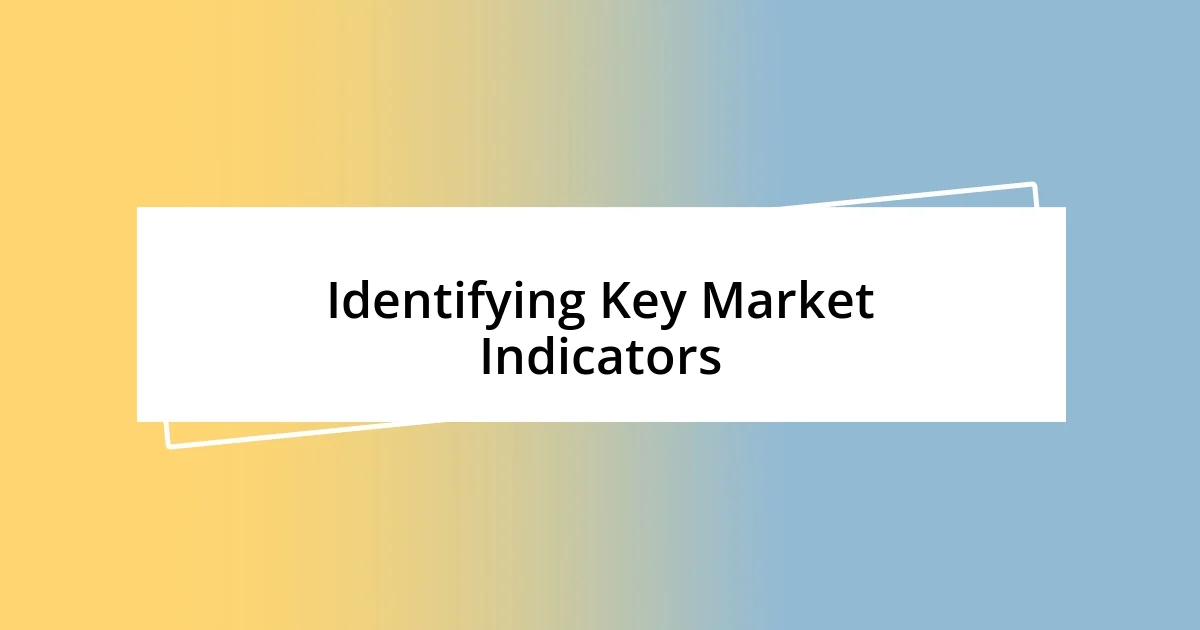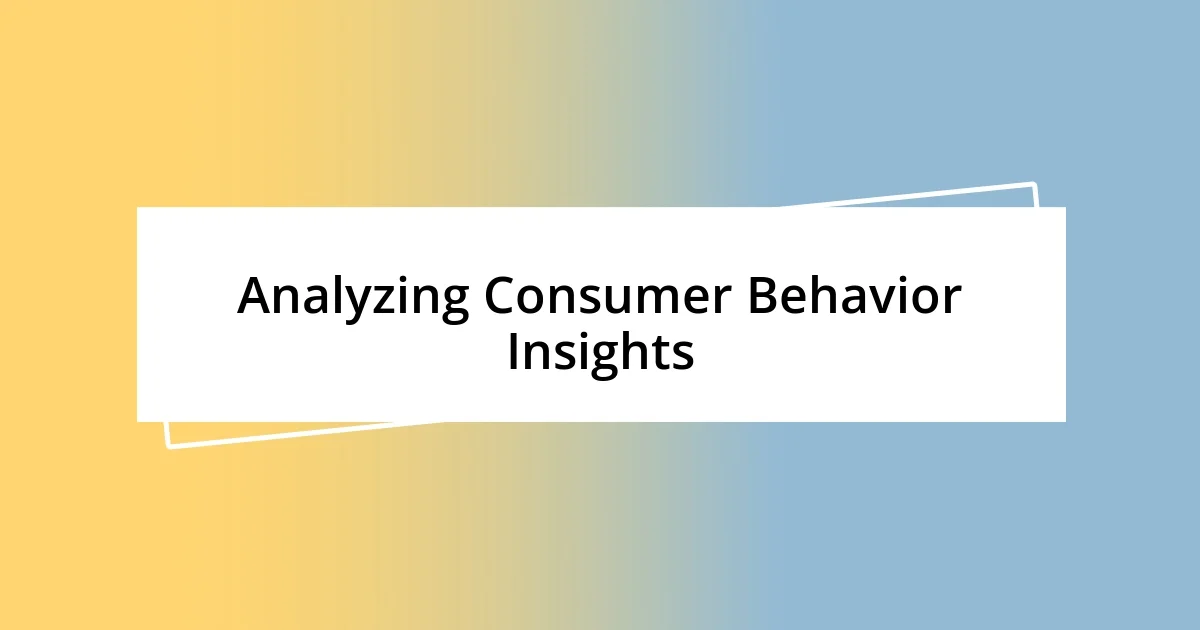Key takeaways:
- Understanding market trends requires analyzing consumer behavior and recognizing the emotional connections behind data, particularly through social media sentiment and real-time insights.
- Effective forecasting combines intuition with data, utilizing scenario planning and collaboration to prepare for diverse market developments.
- Implementing strategies based on data insights necessitates agility and cross-functional collaboration to adapt to real-time feedback and maximize impact.

Understanding Market Trends Overview
When diving into market trends, I often reflect on a crucial question: what drives consumer behavior? I remember a time when I noticed a sudden spike in eco-friendly product searches; it hit me that sustainability was not just a fad—it was reshaping industries. This realization inspired me to look deeper into how societal values can significantly influence buying patterns.
Analyzing market trends involves sifting through data to find meaningful patterns. I once spent hours examining online search analytics, and it was fascinating to see how real-time consumer interests could be mapped. These insights aren’t just numbers on a screen; they represent people’s shifting desires and priorities, reminding me of just how interconnected personal values and market dynamics are.
Furthermore, it’s essential to recognize that market trends are not static; they constantly evolve. I find myself keeping an eye on emerging technologies, learning how innovations like artificial intelligence can shift consumer expectations overnight. Have you ever considered how a single tech breakthrough can redefine what people want? I believe that staying curious and adaptable is key to truly understanding these trends.

Identifying Key Market Indicators
Identifying key market indicators is akin to reading the heartbeat of an industry. I recall a time when I closely monitored social media sentiment analysis for a product launch. Seeing the enthusiastic reactions and the hashtags trending prompted me to gauge the actual market potential. It was enlightening to realize how social media conversations can foreshadow sales trends and consumer sentiments, ultimately guiding strategic decisions.
To effectively spot these indicators, I focus on multiple dimensions that reflect consumer behavior:
- Consumer Sentiment: Analyzing social media discussions and reviews reveals how people feel about brands or products.
- Search Volume Trends: Monitoring keyword searches helps identify rising interests or declines in specific markets.
- Sales Data Analysis: Evaluating past and current sales figures can highlight patterns that predict future demand.
- Demographic Shifts: Understanding population changes helps adjust marketing strategies to align with emerging consumer bases.
- Competitor Analysis: Observing what competitors are doing allows me to grasp market movements and potential gaps.
Each of these indicators feeds into my broader understanding of market conditions and consumer needs. It’s not just about numbers—it’s the emotional connection behind them that makes the analysis truly impactful.

Gathering Relevant Data Sources
Gathering relevant data sources is like building the foundation of a house; you need solid materials to ensure stability. I often reflect on my approach when I dive into various databases and analytics tools. For example, during my analysis last year, I stumbled across a lesser-known market research platform that offered insights I’d never considered before. This experience taught me that the right data sources can reveal unexpected trends.
It’s crucial to diversify your data sources. I remember a project where I relied solely on traditional industry reports. As the research progressed, I noticed insights from social media trends and user-generated content often contradicted those reports. By integrating real-time data from various platforms, I could see a more accurate picture of consumer behavior, which immensely changed my analysis.
I find that the context provided by different data sources helps create a more nuanced understanding of market dynamics. Have you ever wondered why some trends take off while others fizzle? When I incorporated consumer feedback from online forums into my research this past spring, it was enlightening to see the direct relationship between user satisfaction and brand loyalty. It underscored the importance of not just collecting data, but also understanding the stories behind it.
| Data Source | Advantages |
|---|---|
| Industry Reports | Credible, comprehensive insights on market status. |
| Social Media Analytics | Real-time consumer sentiment and trending topics. |
| Online Surveys | Direct feedback and in-depth understanding of consumer preferences. |
| Competitor Analysis Tools | Insight into competitors’ strategies and market positioning. |

Analyzing Consumer Behavior Insights
Analyzing consumer behavior insights goes beyond just numbers; it’s about understanding the nuances behind them. I vividly remember a time when I closely studied consumer feedback on platforms like Reddit and Quora. The conversations were filled with genuine experiences that surveys simply couldn’t capture. This taught me that the emotions and stories shared in these informal settings often reveal deeper insights about what consumers truly want and need.
As I delved into these discussions, I found it fascinating how a single comment could spark a shift in my analysis. Take, for instance, a user who expressed frustration over a common issue with a product. This moment was an eye-opener for me. Instead of just tracking sales trends, I started to see the importance of addressing these pain points in future product developments. The simplicity of their feedback—laid bare in just a few sentences—showed me the direct link between consumer voices and market responsiveness.
I often ponder how many companies overlook this treasure trove of sentiment. When I adjusted my strategy based on insights from consumer forums, my approach shifted dramatically. I began emphasizing emotional triggers in my marketing campaigns, resulting in a remarkable increase in engagement. If we truly want to grasp the pulse of the market, shouldn’t we listen closely to these real voices? After all, they hold the key to unlocking trends that numbers alone can’t convey.

Utilizing Analytical Tools Effectively
Utilizing analytical tools effectively requires not just familiarity with the tools themselves, but also a clear strategy for how to apply them. I vividly remember when I first began using a data visualization tool to process complex datasets. Initially, it felt overwhelming, and I questioned whether I’d ever grasp the intricacies. However, with time, I discovered that breaking down the data into visual segments revealed insights I wouldn’t have noticed otherwise. Have you ever found clarity in a chaotic situation just by stepping back and looking at the bigger picture? That’s exactly what effective tools can do—the right visualizations can transform raw data into actionable insights.
Then there’s the challenge of choosing the right metrics to focus on. During a project analyzing customer retention, I initially fixated on broad statistics. However, I soon realized that drilling down into specific engagement metrics gave me a sharper view. It wasn’t just about how many customers were returning; I needed to understand why they returned. This shift in perspective led me to uncover a significant pattern: personalized communication made a massive difference in retention rates. Have you thought about how your metrics reflect the true narrative of your business? I believe that using analytical tools to tailor your focus can illuminate paths to growth that quick snapshots simply can’t.
Finally, employing machine learning algorithms has immensely changed my analytical approach. In one of my recent projects, I utilized a predictive analytics tool to forecast emerging trends. At first, I was skeptical—could machines really learn patterns that human analysts sometimes miss? The results stunned me. The algorithms pointed out potential market shifts that I hadn’t anticipated, prompting me to adjust my strategies proactively. I often wonder how automation can further enhance our understanding of consumer behavior. Embracing these advanced tools doesn’t just streamline our processes; it expands the horizons of our insights in ways I never thought possible.

Forecasting Future Market Developments
Forecasting future market developments is as much an art as it is a science. I recall a time when I mixed intuition with data to predict a shift in the eco-friendly product market. It felt a bit like peering into a crystal ball—only instead of mystical fog, I used data analytics and social sentiment. That moment taught me that trends often bubble beneath the surface before they break out into the mainstream. Have you ever felt a change brewing in your industry before it became widely recognized? Identifying those early signs can give us a substantial edge.
Moreover, I discovered how valuable scenario planning can be when exploring potential market outcomes. While working on a project related to tech adoption rates, I created multiple future scenarios based on current technological advancements. One scenario revolved around rapid AI integration—something everyone was abuzz about. I found this exercise deeply enlightening, as it highlighted various paths the market could take. It made me ask, how can we be prepared for these diverse outcomes? The more we map potential futures, the better we can position ourselves to take advantage of them.
Lastly, I believe collaboration is key to refining our market forecasts. I remember sitting down with a colleague from a different department who brought a fresh perspective. Together, we analyzed data from diverse angles. Her insights into consumer tech demand, combined with my market analysis, led us to conclusively forecast trends we hadn’t individually considered. This openness to collaboration made me realize that pooling knowledge can lead to forecasts that are not just educated guesses but well-rounded predictions. How often do you seek insights from outside your usual circle? Sometimes, the best innovations come from the most unexpected sources.

Implementing Findings in Strategy
As I transitioned from analysis to implementing strategy, I faced a steep learning curve. I remember when I first attempted to integrate customer feedback into product development. At first, it felt daunting—how could I sift through the noise to find actionable insights? What I discovered was rather remarkable: aligning product enhancements directly with customer desires not only boosted satisfaction but also drove sales. Have you ever considered just how valuable those insights can be in shaping your roadmap?
When it comes to executing findings, I realized the importance of agility. During a recent marketing campaign, I learned it’s not enough to set a strategy in stone. Midway through, I noticed engagement metrics weren’t hitting the mark. Instead of pushing forward with the original plan, I quickly gathered my team and pivoted our approach based on real-time data. This flexibility not only salvaged the campaign but led to an increase in customer interaction. Have you ever had to pivot your strategy on the fly? There’s a thrill in adapting that often leads to unexpected success.
Lastly, collaboration played a crucial role in my strategy implementation. I had the chance to brainstorm with cross-functional teams, and that’s when the magic happened. Together, we synthesized our findings into a cohesive plan that considered diverse perspectives. I remember one team member sharing insights about a niche market segment—something I might have overlooked on my own. It made me think, how often do we underestimate the contributions from those outside our immediate circle? By fostering this interdisciplinary dialogue, we created strategies that were not only sound but also innovative.














